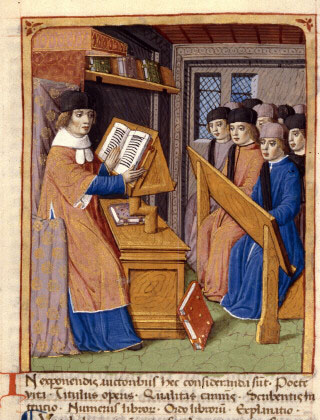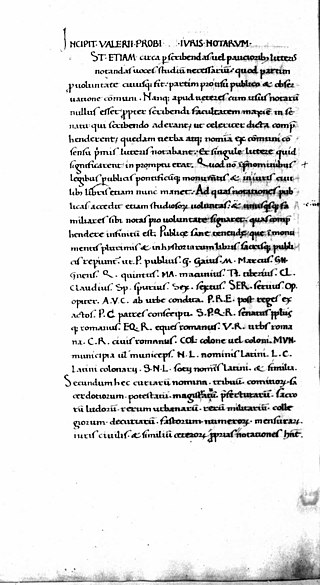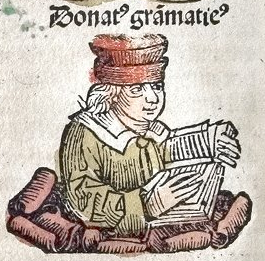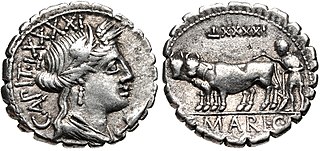Related Research Articles

In ancient Roman religion, the diiNovensiles or Novensides are collective deities of obscure significance found in inscriptions, prayer formulary, and both ancient and early-Christian literary texts.

Servius, distinguished as Servius the Grammarian, was a late fourth-century and early fifth-century grammarian. He earned a contemporary reputation as the most learned man of his generation in Italy; he authored a set of commentaries on the works of Virgil. These works, In Tria Virgilii Opera Expositio, Commentarii in Virgilium, Commentarii in Vergilii Opera, or Vergilii Carmina Commentarii, constituted the first incunable to be printed at Florence, by Bernardo Cennini, in 1471.
Gaius Caesius Bassus was a Roman lyric poet who lived in the reign of Nero.
Quintus Remmius Palaemon or Quintus Rhemnius Fannius Palaemon was a Roman grammarian and a native of Vicentia. He lived during the reigns of Emperors Tiberius and Claudius.

Marcus Valerius Probus, also known as M. Valerius Probus Berytius or Probus the Berytian, was a Roman grammarian and critic, who flourished during Nero's reign.

Aelius Donatus was a Roman grammarian and teacher of rhetoric.
Quintus Terentius Scaurus was a Latin grammarian who flourished during the reigns of Trajan and Hadrian.
Flavius Sosipater Charisius was a Latin grammarian.
Aemilius Asper, Latin grammarian, possibly lived in the 1st century AD or late 2nd century AD.
Publius Consentius was a 5th-century Latin grammarian and the author of two treatises, which are perhaps the fragments of a complete grammar: Ars de duabus partibus orationis, nomine et verbo, on the noun and the verb, which was much used during the Carolingian period, and Ars de barbarismis et metaplasmis, on barbarisms and metaplasm. The latter refers to a third essay, De structurarum ratione, on the structure of sentences, which, if ever published, no longer exists.
Gaius Marius Victorinus was a Roman grammarian, rhetorician and Neoplatonic philosopher. Victorinus was African by birth and experienced the height of his career during the reign of Constantius II. He is also known for translating two of Aristotle's books from ancient Greek into Latin: the Categories and On Interpretation. Victorinus had a religious conversion, from being a pagan to a Christian, "at an advanced old age".
Dositheus Magister was a Greek grammarian who flourished in Rome in the 4th century AD.
In music and prosody, arsis and thesis are respectively the stronger and weaker parts of a musical measure or poetic foot. However, because of contradictions in the original definitions, writers use these words in different ways. In music, arsis is an unaccented note (upbeat), while the thesis is the downbeat. However, in discussions of Latin and modern poetry the word arsis is generally used to mean the stressed syllable of the foot, that is, the ictus.
Diomedes Grammaticus was a Latin grammarian who probably lived in the late 4th century AD. He wrote a grammatical treatise, known either as De Oratione et Partibus Orationis et Vario Genere Metrorum libri III or Ars grammatica in three books, dedicated to a certain Athanasius. Since he is frequently quoted by Priscian, he must have lived before the year 500. His third book on poetry is particularly valuable, containing extracts from Suetonius's De poetica. This book contains one of the most complete lists of types of dactylic hexameters in antiquity, including the teres versus, which may be the so-called "golden line." Diomedes wrote about the same time as Charisius and used the same sources independently. The works of both grammarians are valuable, but whereas much of Charisius has been lost, the Ars of Diomedes has come down to us complete. In book I he discusses the eight parts of speech; in II the elementary ideas of grammar and of style; in III poetry, quantity, and meters. The best edition is in H. Keil's Grammatici Latini, vol I.
A sicilicus was an old Latin diacritical mark, ͗, like a reversed C (Ɔ) placed above a letter and evidently deriving its name from its shape like a little sickle. The ancient sources say that during the time of the Republic it was placed above a geminate consonant to indicate that the consonant counted twice, although there is hardly any epigraphic or paleographic evidence available from such an early time. When such geminate consonants began to be represented during classical times by writing the letter twice, the sicilicus naturally fell into disuse in this function, but continued to be used to indicate the doubling of vowels as an indication of length, in the developed form of the apex. Fontaine suggests that Plautus alludes to the sicilicus in the prologue to Menaechmi.
An ars grammatica is a generic or proper title for surveys of Latin grammar. The first ars grammatica seems to have been composed by Remmius Palaemon, but is now lost. The most famous ars grammatica since late antiquity has been that composed by Donatus.

In ancient Greek geometry, the Ostomachion, also known as loculus Archimedius or syntomachion, is a mathematical treatise attributed to Archimedes. This work has survived fragmentarily in an Arabic version and a copy, the Archimedes Palimpsest, of the original ancient Greek text made in Byzantine times.

The gens Maria was a plebeian family of Rome. Its most celebrated member was Gaius Marius, one of the greatest generals of antiquity, and seven times consul.
Titus Annianus was a poet of ancient Rome, who lived in the time of the emperors Trajan and Hadrian, and wrote erotic or light verse, possibly in the Faliscan language.
Marius Plotius Sacerdos was a Roman grammarian who flourished towards the end of the third century CE. He wrote an ars grammatica in three books, the third of which treats of meter.
References
- ↑ Monceaux (1905), p. 389, quoted by Bruce.
- ↑ Bruce (1949), p. 138.
- ↑ Rita Copeland and Ineke Sluiter, Medieval Grammar and Rhetoric: Language Arts and Literary Theory, AD 300-1475 (Oxford: Oxford University Press, 2012), p. 124 n. 3; ISBN 9780199653782.